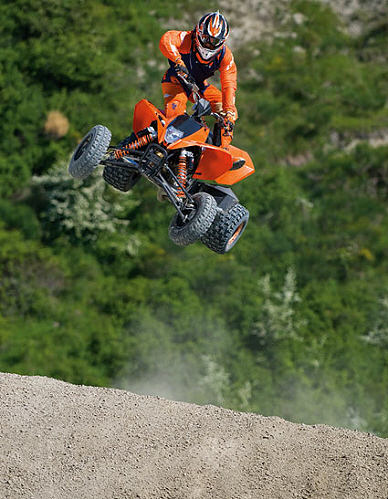Ask the Editors: The Secret Techniques of Jumping an ATV
I took my first trip to the dunes the last couple days, and had a great time.
I had never ridden in the sand let alone went up large inclines or attempted jumps before. My friends said I did excellent for my first time out, but I am sure I have much more to learn.
So, I am here to ask; what techniques to you all recommend for jumping? Will it just take more and more practice?
Also, I still don’t have a sport quad yet (I borrowed a Suzuki 400 at the dunes), I plan on getting a Raptor 700. What needs to be done to make a quad better suited for the jumps?
-Call911
Jumping, like all aspects of the riding experience, is an exercise in the law of physics. When you take your machine skyward, there are several factors at play including aircraft designations roll, pitch and yaw. But before we get to that, let’s talk about body positioning and proper set-up.
The lighter the ATV, the better for jumping generally speaking. The reason for this is that in an ideal environment, each and every jump you make would be at the proper speed, body-positioning and traction. However since this is the real world, and many times we flub one (or all) of the factors responsible for a nice arced flight, oftentimes we are forced to make corrections in the air. The more a machine and rider weigh at take-off, the more difficult it is to make mid-flight corrections due to the concept of mass and momentum. Situations that demand you use body English (like muscling the front end up for example) to make corrections always favor the lighter.
Body positioning is actually similar to if you were attacking a technical section of trail: Standing, loose but ready, slight bend in the knees and elbows and prepared to move around the machine’s cockpit as needed. This applies to both takeoff and landing. ATV set-up is surprisingly simple: In addition to weight shaving measures, you are going to want to run your suspension clickers on the stiff side so as to absorb big hits. The trade-off here is that you lose small bump sensitive in the process but the last thing you want to do is blow through your vehicle’s suspension travel. Metal on metal contact from bottoming out can be damaging to your machine and body as well.
An ideal jump will have you landing not on flat ground, which causes all the stored energy of you and your ATV to become transferred upward into your tires, wheels, shocks and frame the instant you make contact with the ground.
On the other hand, angling your ATV to coincide with the slope of a steep hill when you touch down transfers much of that energy into forward motion and hence is a much softer landing. This explains why jump courses often boast massive landing mounds as big as if not bigger than the face of the jumps themselves. These landings are called transitions (or trannies) and they are instrumental in keeping you safe during big air flights; you’ll never find a freestyle course without them!
There is one other physics lesson you may wish to familiarize yourself with: Kinetic energy that comes from the spinning rear wheels of your quad in flight. To make corrections to your quad’s flight-path beyond the ability of just body English, you can tap into this energy. How? You can either rev the engine in the air to make the front end rise a bit or yank in the clutch and tap the rear brake to make the front end dip. The reason this works is the energy of those spinning wheels can be transferred into the machine’s frame the moment the brake pads made contact with the spinning rotor, hence rotating the entire machine forward. The catch is that it only works once per flight, so use it sparingly.
Lastly we spoke of roll, pitch and yaw: Roll is movement about a horizontal axis (think of an airplane’s wings rising or dipping), pitch is also about a horizontal axis (nose pointing upward or down) and finally yaw is rotation about a vertical axis (turning left or right). More on that can be found here.
Like all riding techniques, practice certainly makes perfect!


